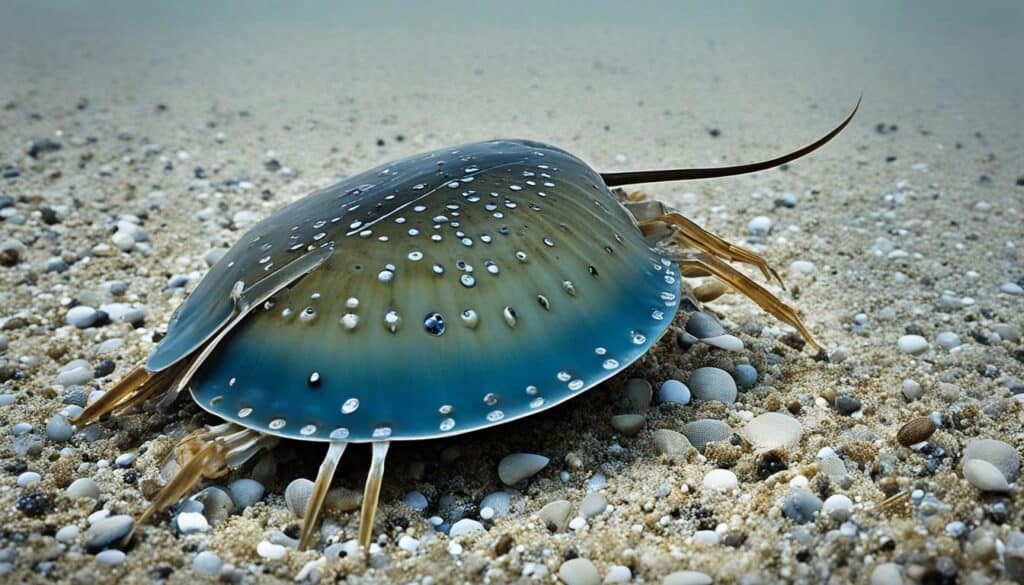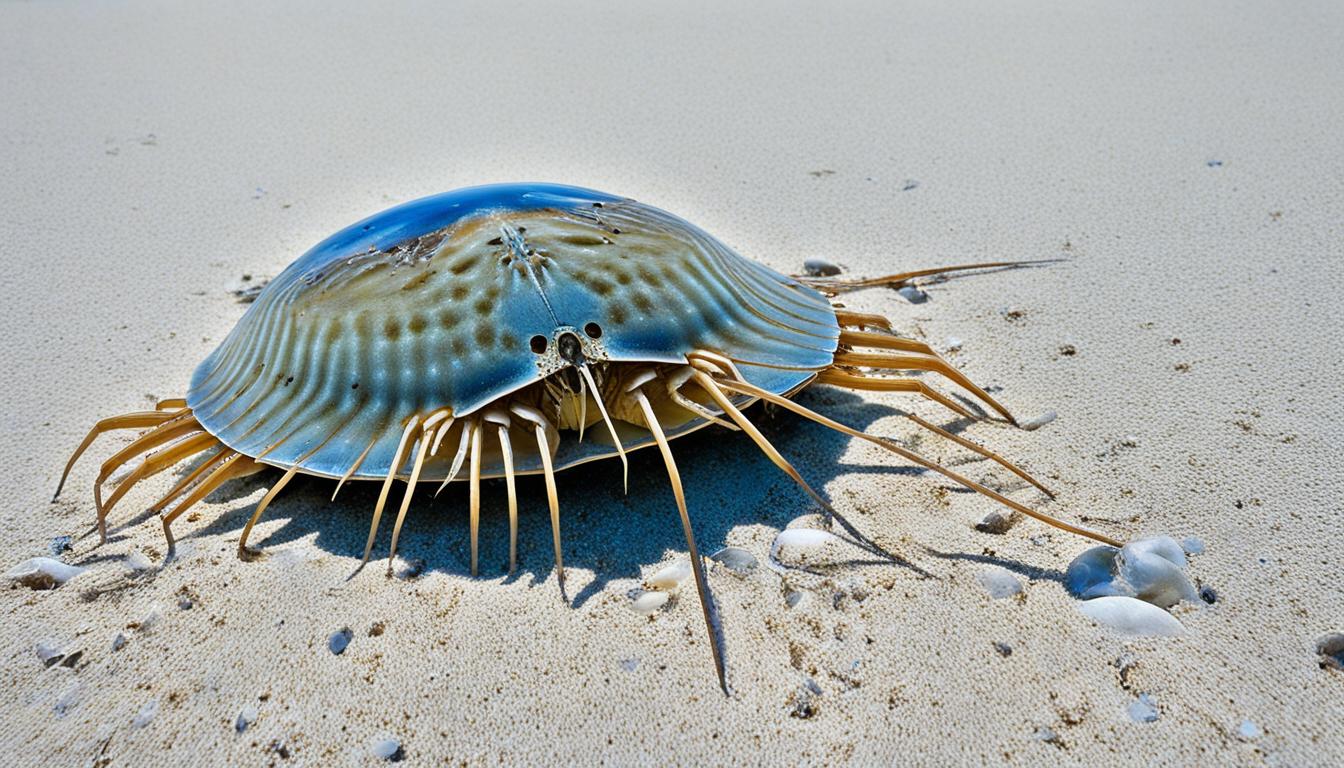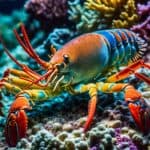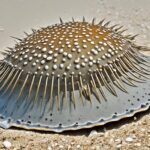Have you ever thought about how horseshoe crabs, known as Limulus polyphemus, have survived for over 450 million years? They have many adaptations that help them live in different marine environments. Their hard shell protects them from predators, and they have a special way to fight off bacteria.
These ancient creatures are very good at adapting to changes in temperature and salt levels in the water. Learning about how horseshoe crabs adapt shows us their amazing biology and their importance in our ecosystem.
Introduction to Horseshoe Crab Adaptations
Horseshoe crabs have lived for millions of years and have adapted to many environments. They are known as Limulus polyphemus. These creatures have developed many physical and behavioral traits to survive. Learning about their adaptations helps us understand their important role in the ocean.
These crabs have tough shells that protect them from predators and harm. They also have special organs that help them sense light and vibrations. These senses are key to finding food and avoiding danger.
How they behave is also crucial to their survival. They dig burrows for shelter and to lay eggs. Their migrations are important for finding places to breed and eat. By studying their habits, we see how they adapt to their world.
Horseshoe Crab Habitat and Its Influence on Survival
The horseshoe crab’s home is crucial for their survival. They live on the sandy bottoms of shallow seas and bays. This place is perfect for digging burrows and laying eggs. They also find plenty of food, like buried worms and mollusks, which they need to survive.
Horseshoe crabs have special traits that help them live in different places. Changes in salt levels and temperature affect how well they can reproduce. They can live in many environments, showing how well they’ve adapted over time. Protecting their homes is key to keeping this ancient species alive.
How do horseshoe crabs adapt to their environment?
Horseshoe crabs are amazing creatures that can live in many places. They have special ways to survive and play a key role in their world.
Ecological Generalists: Surviving Diverse Conditions
Horseshoe crabs are great at living in different places. They can adapt to many habitats, from coastlines to deep sea. This lets them handle changes in their environment well.
They can use many resources to survive, which helps them a lot.
Burrowing Behavior for Reproductive Success
Burrowing is very important for horseshoe crabs to have babies. They dig holes in sandy places to lay their eggs. This keeps the eggs safe from predators and helps them grow.
This behavior is a big part of how they survive and thrive.
Adaptations to Temperature and Salinity Variations
Horseshoe crabs can handle changes in temperature and salt levels. Young ones are especially good at this. It helps keep their numbers steady, even when their home changes.
The Role of Vision in Horseshoe Crab Adaptation
Horseshoe crabs have an amazing way of seeing the world. Their eyes are complex and have evolved over millions of years. These eyes help them find food, navigate, and even find a mate.
Type and Function of Multiple Eyes
These creatures have ten eyes, each with a special job. The main eyes help them spot potential mates. Other eyes keep them informed about their surroundings, helping them react fast to dangers.
This shows how horseshoe crabs have adapted over time. Their vision is a result of natural selection.
Ultraviolet Light Detection for Night Survival
Horseshoe crabs can see ultraviolet light, which is key at night. This lets them find food in the dark. Their ability to see in ultraviolet shows how they’ve adapted to survive in different places.

| Eye Type | Function |
|---|---|
| Lateral Eyes | Mating detection |
| Medial Eyes | Light intensity measurement |
| Other Eyes | Environmental awareness |
| Ultraviolet Detecting Eyes | Night navigation and prey location |
Physical Adaptations: Carapace and Legs
The horseshoe crab has amazing physical traits that help it survive in different places. Its hard carapace and special legs are key to its survival. These features protect it, help it move, and aid in finding food.
Functionality of the Hard Carapace
The horseshoe crab’s hard shell is a prime example of its survival skills. This strong outer layer acts as a shield against predators. It doesn’t make it completely safe, but it helps a lot during threats. The shell also homes various organisms, creating a helpful relationship with them.
Walking Legs and Feeding Mechanisms
Horseshoe crabs have many walking legs that let them move on different grounds. These legs are vital for how they move and eat. They use special limbs to pull organic matter from the ocean floor. This shows how adaptable horseshoe crabs are in various environments.
| Adaptation | Function | Importance |
|---|---|---|
| Hard Carapace | Provides defense against predators | Enhances survival chances |
| Walking Legs | Facilitates movement and digging | Increases efficiency in foraging |
| Feeding Mechanisms | Modified limbs for substrate harvesting | Ensures access to nutrients |
Horseshoe Crab Behaviors for Survival
Horseshoe crabs have special behaviors that help them survive in the ocean. They are most active at night, which is when many predators sleep. This lets them eat more without being eaten themselves. It shows how important timing is for their survival.
During breeding season, horseshoe crabs dig burrows to lay their eggs. This keeps their babies safe and helps them hatch more successfully. It’s a key way they adapt to survive and keep their species going.
Horseshoe crabs are very adaptable, thanks to their varied behaviors. They can live in different places and handle many challenges. Their ability to adapt shows how they’ve managed to stay important in the ocean for so long.
FAQ
What adaptations help horseshoe crabs survive in their environment?
Horseshoe crabs have many adaptations. They have a hard shell for protection and a special immune system to fight bacteria. They also have ten eyes to help them see and move around.
Where do horseshoe crabs typically live?
Horseshoe crabs live on the sandy bottoms of shallow seas and bays. They dig burrows and lay their eggs there. These places are important for their survival because they offer food and safe spots for laying eggs.
How do horseshoe crabs reproduce?
Horseshoe crabs dig to lay their eggs in sandy areas. This keeps the eggs safe from predators. The sandy environment helps the eggs grow and develop well.
What role does temperature and salinity play in horseshoe crab survival?
Horseshoe crabs can handle changes in temperature and salinity, especially when they are young. This helps them reproduce and adapt to different environments.
How do horseshoe crabs use their eyes for survival?
Horseshoe crabs have ten eyes that help them in different ways. Some eyes help them find mates, and others see ultraviolet light. This helps them navigate and find food at night, which is important for their survival.
What is the significance of horseshoe crab behaviors like nocturnal feeding?
Eating at night helps horseshoe crabs avoid predators and increases their chances of finding mates. These behaviors show how they have evolved to survive and thrive in their environment.
Why is the hard carapace important for horseshoe crabs?
The hard shell of horseshoe crabs protects them from predators. It also lets other organisms attach to them, showing a symbiotic relationship. This shell is key to their survival in different places.
What unique feeding mechanisms do horseshoe crabs possess?
Horseshoe crabs use special limbs to find and eat buried worms and mollusks. Their ability to dig into the ground shows how they adapt to feed in various places.







